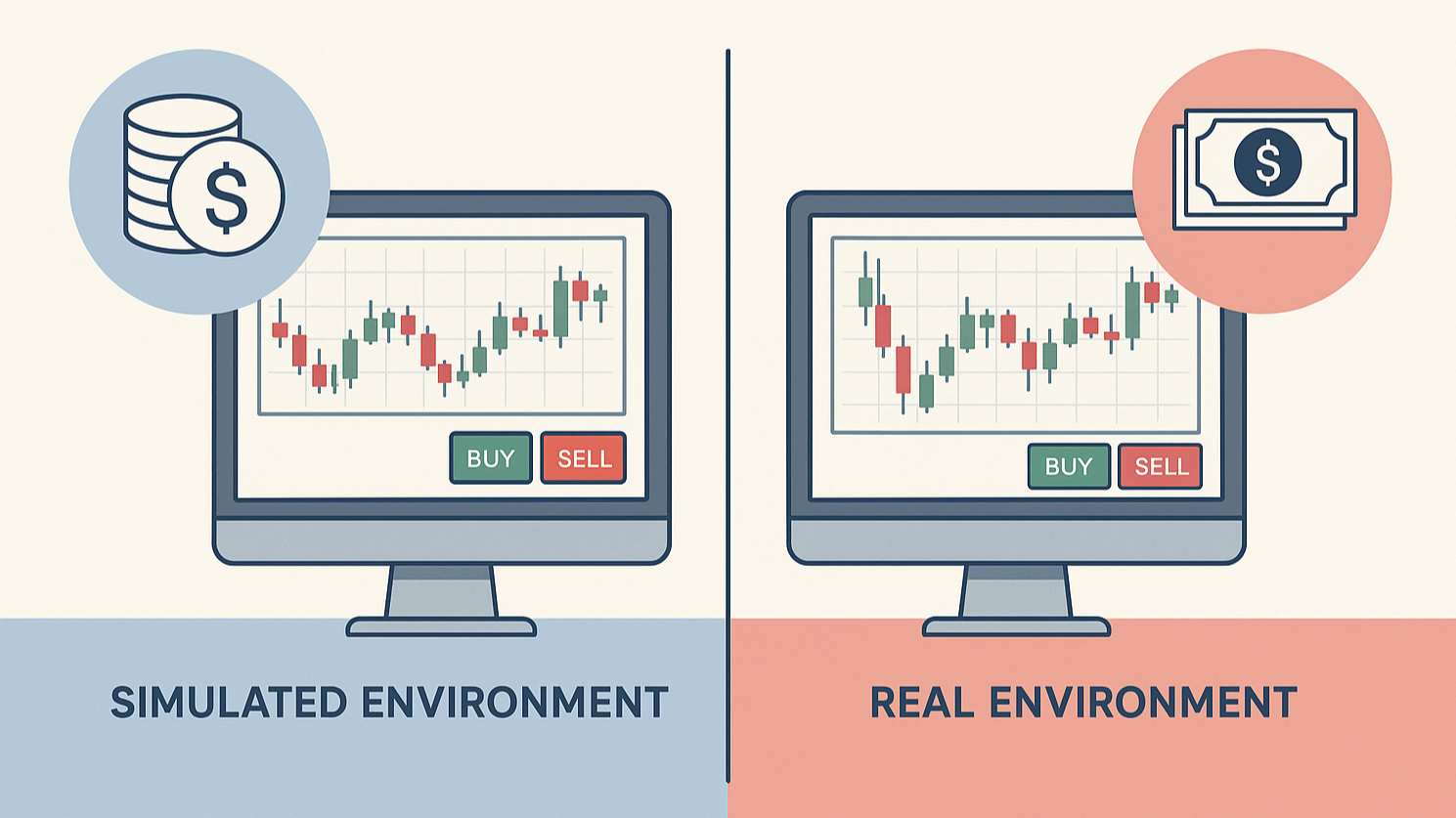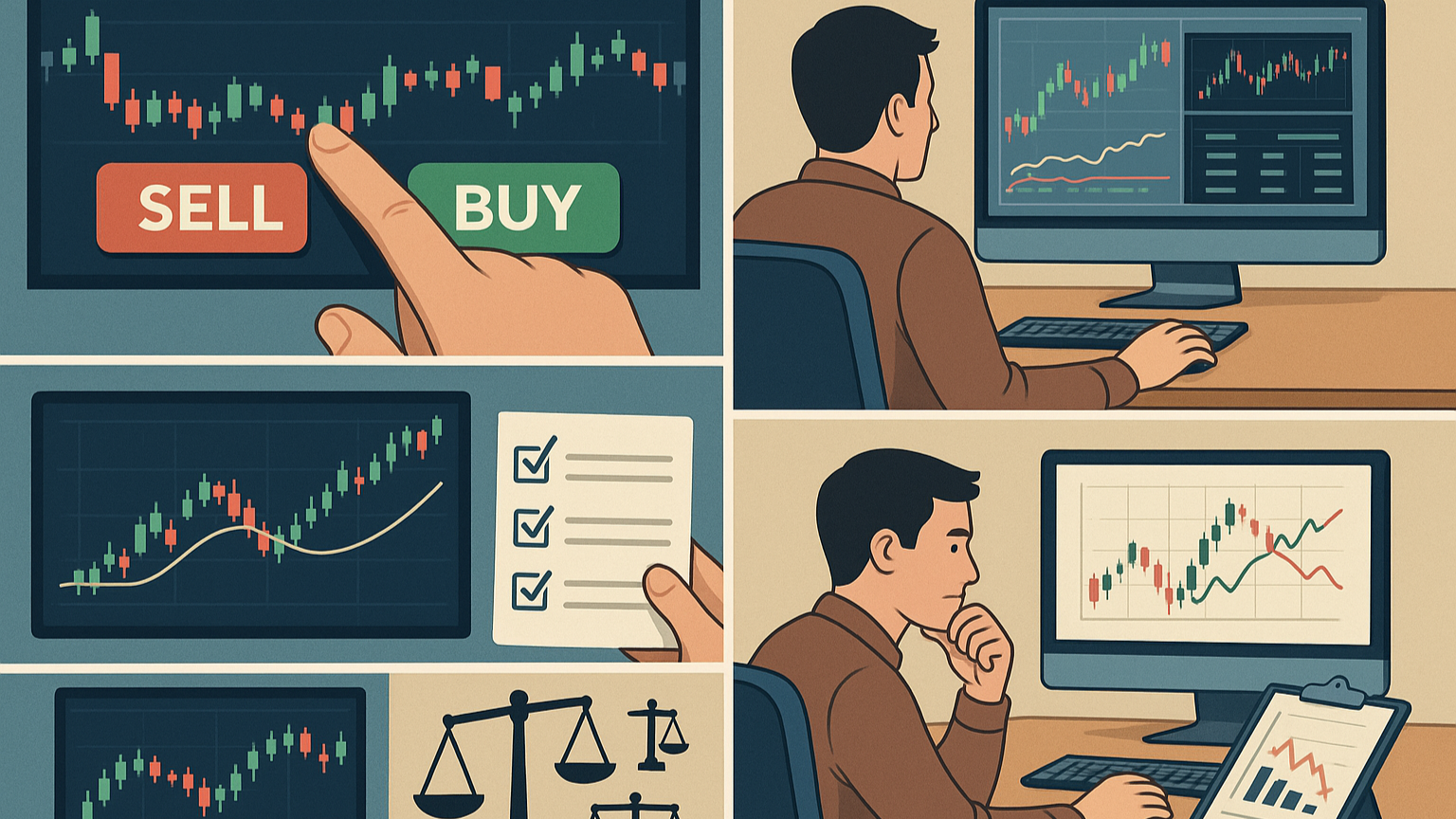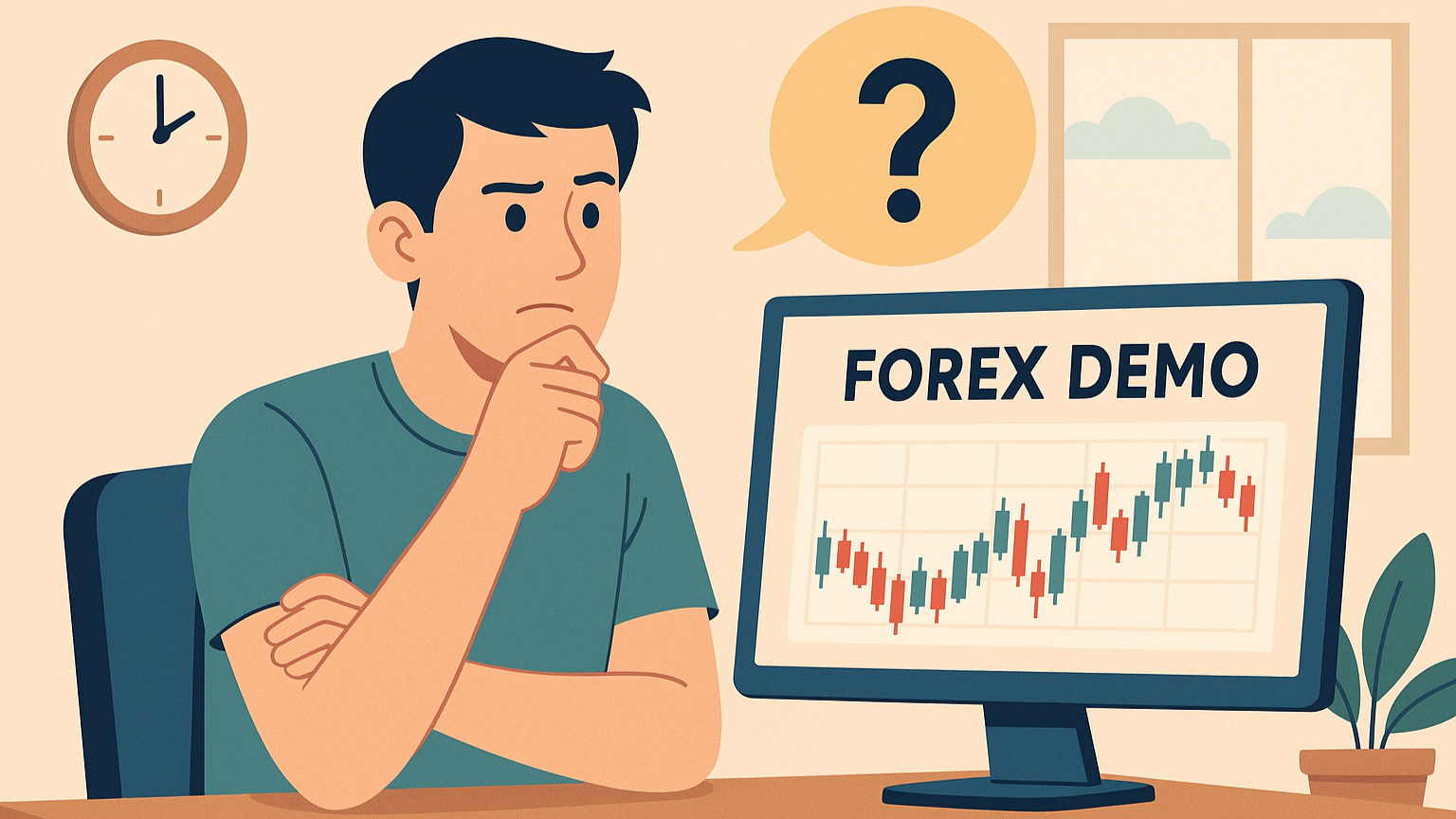Most new forex traders make the same costly mistake: they skip demo trading and jump straight into live markets. The result? Blown accounts, frustration, and the false belief that forex is “just gambling.”
The truth is, demo trading is not optional it’s the training ground every trader needs before risking a single dollar. A forex demo account gives you a risk-free environment to practice, learn, and build discipline so that when you finally go live, you’re prepared for the real challenges.
In this guide, we’ll explore why demo trading is so important, the differences between demo and live accounts, how long you should practice, and the common mistakes to avoid.
Table of Contents
What Is a Forex Demo Account?

A forex demo account is a simulated trading environment offered by almost every broker. It mirrors real market conditions price data, spreads, charts but uses virtual funds instead of real money.
Platforms like MT4, MT5, cTrader, and TradingView allow you to place trades exactly as you would in live markets. You can buy and sell currencies, set stop loss and take profit orders, test strategies, and manage risk all without losing a cent.
Why Demo Trading Matters Before Going Live

1. Learn the Platform Without Expensive Mistakes
Placing trades on MT4 or TradingView may seem simple, but even small errors like setting a stop loss on the wrong side can wipe out real money instantly. Demo trading lets you get comfortable with order types, charting tools, and trade execution risk-free.
2. Strategy Testing Without Risk
Everyone has a strategy idea: moving averages, breakouts, support/resistance. But not every strategy works. In demo, you can test your setups in real market conditions before committing real funds.
3. Build Risk Management Habits
Risk management separates survivors from gamblers. A demo account helps you practice risking 1-2% per trade, adjusting lot sizes, and respecting stop-losses. These habits are hard to build once money is on the line.
4. Develop Psychological Discipline
Even though demo doesn’t involve real money, it trains you to wait for good setups, avoid overtrading, and log your trades. Treating a demo seriously is the best way to prepare for the emotional rollercoaster of live trading.
5. Spot Weaknesses Early
Do you overtrade after losses? Do you ignore your rules when a setup looks tempting? Demo exposes these weaknesses so you can correct them before real money magnifies them.
Demo vs Live Forex Trading: Key Differences Every Trader Must Know

It’s true demo accounts cannot fully replicate live trading emotions. But that doesn’t make them useless. In fact, understanding the differences between demo and live forex trading is exactly what helps you bridge the gap and prepare for real markets.
Here’s a complete breakdown:
1. Order Execution and Trade Fills
- Demo trading: Orders are usually filled instantly at the displayed price. There’s little to no slippage.
- Live trading: Execution depends on market liquidity. Spreads widen, slippage happens, and sometimes your order may only partially fill.
Why it matters: In demo, you may think your strategy is flawless. In live markets, execution costs and slippage can turn winning trades into breakeven or even losses.
2. Risk Exposure and Real Money Pressure
- Demo trading: You’re playing with virtual funds, so losses don’t hurt.
- Live trading: Every trade involves real money. Losses impact your account balance and sometimes your emotions.
Why it matters: Risk feels abstract in demo. In live trading, even small positions can trigger fear of loss or greed after a win.
3. Trading Psychology: Emotions Amplify in Live Accounts
- Demo trading: It’s easier to stay calm, follow rules, and cut losses because nothing is truly at stake.
- Live trading: Fear, greed, hesitation, and FOMO (fear of missing out) become powerful forces that test your discipline.
Why it matters: Psychology is often the biggest reason traders fail. Demo helps you build habits, but only live trading shows how you handle emotional stress.
4. Mistakes and Consequences
- Demo trading: Mistakes cost nothing – you can reset your account anytime.
- Live trading: Mistakes are expensive. A missed stop loss, oversized lot, or revenge trade can destroy weeks of progress.
Why it matters: Demo is the perfect place to make mistakes, analyze them, and refine your process before real money is on the line.
5. Confidence Building vs Reality Testing
- Demo trading: Builds technical confidence you learn how to place trades, test strategies, and manage risk in a safe environment.
- Live trading: Tests your real world readiness can you apply those same skills under pressure, with real money at risk?
Why it matters: Demo gives you skills. Live trading tests your discipline and mental resilience. Both are essential stages in the trader’s journey.
Quick Comparison Table: Demo vs Live Forex Trading
| Aspect | Demo Trading (Practice) | Live Trading (Real Money) |
|---|---|---|
| Execution | Instant fills, no slippage | Slippage, spread changes, partial fills |
| Risk | No real money involved | Real capital is at stake |
| Psychology | Easier to stay calm | Fear, greed, and stress amplified |
| Mistakes | No financial consequences | Real money losses |
| Purpose | Skill-building and testing | Profit-making with discipline |
The Smart Way to Use Demo Before Going Live
Demo trading isn’t pointless it’s preparation. Use it to:
- Master your trading platform and tools.
- Test your strategy across 50-100 trades.
- Practice consistent risk management.
- Build habits of patience and discipline.
Then, transition to live markets with small positions and reduced risk until your confidence and discipline carry over.
How Long Should You Practice Forex Trading on a Demo Account?

One of the most common beginner questions is: “How long should I stay on demo before going live?” The truth is, there’s no one size fits all answer. Some traders are ready in a month, while others may need several months of consistent practice.
The real goal isn’t time it’s consistency and discipline. Most experts recommend staying on demo until you’ve placed at least 50 – 100 trades using the same strategy and achieved steady results. This gives you enough data to know whether your system and habits are reliable.
Signs You’re Ready to Move From Demo to Live Trading
- Consistent discipline: You can follow your trading rules without constantly breaking them (aim for 80%+ discipline score).
- Positive expectancy: Over a series of trades, your average wins are bigger than your average losses.
- Proper risk management: You always keep risk at or below 1-2% per trade.
- Emotional control: You’ve faced losing streaks on demo but resisted the urge to revenge trade or abandon your plan.
If you can confidently check these boxes, you’re closer to being ready for live trading.
Why Rushing From Demo to Live Is Dangerous
Moving too quickly often leads to blown accounts. Demo accounts are like flight simulators they prepare you for real conditions without the cost of mistakes. If you skip this stage, your first “lesson” in live markets will come at the expense of your money.
Pro tip: If you’re unsure, stay on demo longer. Practicing risk-free is always cheaper than losing real capital.
From Demo to Live Forex Trading: How to Make a Smooth Transition

Completing your practice on a demo account is only the first step. The real challenge begins when you start trading with actual money. Jumping straight into live trading with full risk is one of the fastest ways to lose your capital. Instead, the shift should be gradual, controlled, and disciplined.
1. Start Small With Risk
For your first 20 live trades, keep risk very low around 0.25% to 0.5% of your account per trade. This keeps potential losses small while you adjust to the emotions of real-money trading.
2. Keep Using Your Demo Account
Your demo doesn’t end when you go live. Use it as a testing ground for new strategies, indicators, or trade ideas before applying them in real markets. This way, your live account stays protected.
3. Track Your Emotions in a Trading Journal
Live trading introduces fear, greed, and hesitation that demo cannot replicate. Record not only your entries and exits but also how you felt during each trade. Did you hesitate? Did a loss tempt you to revenge trade? This helps you refine both strategy and psychology.
4. Scale Risk Slowly
Only after completing 50+ disciplined live trades with consistent results should you consider increasing risk. Even then, do it gradually never jump from 0.5% to 2% overnight.
Why This Transition Plan Works
By starting small, keeping demo for testing, and monitoring your emotions, you carry your demo trading discipline into live markets. This prevents emotional shocks, avoids big drawdowns, and builds confidence step by step.
Common Mistakes Traders Make With Forex Demo Accounts

Demo trading is one of the most valuable tools for beginners, but many traders misuse it and end up learning bad habits instead of building real skills. Here are the most common demo account mistakes and how to avoid them.
1. Treating Demo Like a Game
It’s tempting to place random trades just for fun, but this creates a gambling mindset. A demo account should be a practice ground for discipline, not entertainment.
2. Constantly Switching Strategies
Many beginners change strategies every few days, never giving themselves enough data to know if a system actually works. Real improvement comes from testing one strategy for at least 50-100 trades before making changes.
3. Ignoring Position Sizing
On demo, traders often open oversized positions because there’s no financial risk. But if you trade 5-lot positions on demo when you can only afford 0.05 lots live, you’re creating unrealistic expectations.
4. Going Live Too Soon
A few winning trades in demo doesn’t mean you’re ready for real money. Jumping into live trading without consistency usually leads to blown accounts and frustration.
How to Fix These Mistakes
The golden rule: treat your demo account exactly like a live account.
- Risk only 1-2% per trade.
- Stick to one strategy until you gather enough data.
- Keep a trade journal and track your results.
- Practice patience and discipline, not just profit.
FAQs
Do demo results translate to real profits?
Not perfectly but they show whether your strategy and risk management can work. The biggest change is psychology when real money is on the line.
How long should I use a demo account?
Until you’ve proven consistency over at least 50-100 trades on one strategy. For most beginners, this takes 1-3 months.
Can I trade only on demo forever?
Yes, but you’ll never experience the emotional side of trading. Demo is a tool, not the end goal.
How do I simulate real emotions in demo?
Try challenges: cap yourself at max 3 trades per day, stop after 2 consecutive losses, or track a “discipline score” to add pressure.
Conclusion
Forex trading isn’t about luck it’s about rules, discipline, and patience. A demo account gives you a safe space to make mistakes, test strategies, and build risk management habits before your money is at stake.
Skipping demo is like trying to fly a plane without simulation training you might take off, but you won’t last long.
Treat demo seriously, graduate when you’re ready, and your transition to live trading will be smoother, safer, and more profitable.


